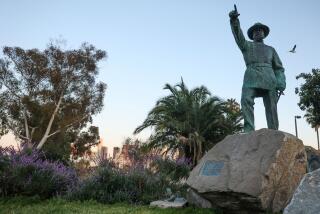Authorities say ancient mosaic seized at Palmdale home was looted from war-torn Syria
- Share via
The ancient mosaic depicts Hercules and other figures from Roman mythology and is believed to date from the 3rd or 4th century. It is 18 feet wide and 8 feet tall, and weighs one ton.
The Byzantine artwork was seized by FBI agents in 2016 at the Palmdale home of Mohamad Yassin Alcharihi, who is accused in a complaint filed in federal court in Los Angeles this week of smuggling the antiquity into the U.S. and concealing it at his residence.
Authorities say the relic was looted from war-torn Syria.
The mosaic is “an authentic mosaic from the Byzantine Period depicting Roman mythology, and was consistent with the iconography of mosaics found in Syria, in particular in and around the city of Idlib, Syria,” according to an expert retained by the government to examine the piece.
The city of Idlib in Syria has been the backdrop for fierce fighting between President Bashar al-Assad’s government forces and opposition fighters and ISIS at times since 2011. The war has left many historic buildings and their valuables in ruins.
As a result, U.S. Customs and Border Protection and the Treasury Department two years ago announced import restrictions for archeological and ethnological materials removed from Syria on or after March 15, 2011.
“The appearance in the United States of stolen or illegally exported artifacts from other countries where there has been pillage has, on occasion, strained our foreign and cultural relations,” the government reasoned. “It became apparent that it was in the national interest of the United States to join with other countries to suppress illegal trafficking of such objects in international commerce.”
Authorities contend Alcharihi was trying to cash in on the spoils of the war in Syria by using a well-known black-market trade route through Turkey. Originally from Syria, Alcharihi is a naturalized citizen who is accused of failing to declare the mosaic among other items he imported from Turkey in 2015 to avoid duty costs and of hiding the artwork’s origin in his native country.
But Alcharihi maintains that he’s no black-market arts dealer. In a 2016 court petition to have the mosaic returned, he described himself as a “chemical engineer by education” who works as a technical engineer for a printing supply company while restoring cars and reselling them for cash on the side.
“This is my first time [with art], and it ended up with a seizure,” he said in a brief phone interview with the Los Angeles Times. “I put all my money in it.”
In January 2016, Alcharihi hired experts who could restore the mosaic for $40,000 so he could resell it.
The 1,000-year-old mortar used to originally afix the tiles was mostly gone by the time Alcharihi acquired the mosaic, the restoration workers noted, and it appeared to have been replaced sometime in the 1960s or ’70s with a neoprene synthetic rubber glue.
Alcharihi’s restoration, in turn, used cement-based mortar with steel T-bolts underneath that connected to the mosaic’s new, fiberglass substrate, documents show. Some tessera were damaged and others were missing when it was rolled up and transported overseas, but those too were restored. The mosaic was cut into five sections and reconnected at the end.
After the restoration, the mosaic could be sold for between $200,000 and $500,000, “based on the relative ignorance of the U.S. purchaser whether it be an individual collector, an antiquities museum, a dealer, or an art shop,” Alcharihi wrote in his petition. “An experienced and sophisticated buyer overseas who understands the meaning of the now freshly restored mosaic and its value has verbally offered me more.”
The mosaic’s potential value is based in part, Alcharihi allegedly told potential buyers, on the significance of the figures it includes.
In one email, Alcharihi claimed the mosaic showed Hercules being freed from imprisonment after fighting his enemies, court documents show. He allegedly wrote that Aphrodite and Zeus were also pictured along with a “black bird.”
But according to USC’s Ann Marie Yasin, an associate professor of art history and classics at USC, the mosaic shows Prometheus, who stole fire from the gods and gave the spoils to mortals, and Hercules, the half-god known for his adventures and feats of strength.
Prometheus, who stole from the gods and gave the spoils to mortals, is shown strapped to a rock so an eagle can tear at his liver for eternity as punishment, Yasin said. Hercules is his rescuer and is pictured preparing to shoot the eagle with a bow and arrow to free Prometheus.
Unfortunately, Yasin said, much of the piece’s value is lost without knowing more about its origins and how and where it was displayed.
“That’s one of the things that makes objects like this so tragic … once it’s been taken out of its location, its architectural position or surround, what we can say about it is extremely limited,” Yasin said. “Without that context, we’re really handicapped.”
For breaking California news, follow @JosephSerna on Twitter.
More to Read
Sign up for Essential California
The most important California stories and recommendations in your inbox every morning.
You may occasionally receive promotional content from the Los Angeles Times.














